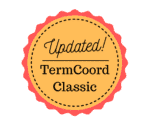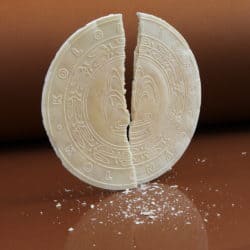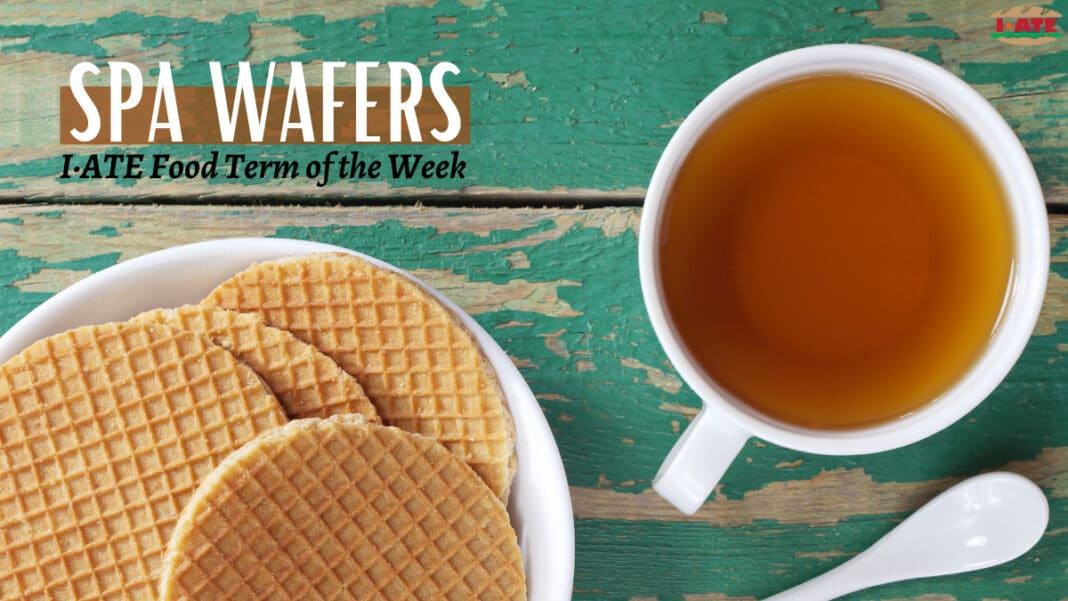 This week, we will please our sweet tooth, at least theoretically. Have you heard or read about the spa wafers? We are not asking the ones who have tried them, because they are already on their way to get some as they recalled the typical crunch and the delicate sweet taste that the bit melting on the tongue distributes to the senses…
This week, we will please our sweet tooth, at least theoretically. Have you heard or read about the spa wafers? We are not asking the ones who have tried them, because they are already on their way to get some as they recalled the typical crunch and the delicate sweet taste that the bit melting on the tongue distributes to the senses…
 Some claim that the original recipe for spa wafers dates back to the 15th century, but the first note mentions a housewife serving them to her guests in the Czech city Karlovy Vary in 1770. Probably the most famous type of the spa wafers, Karlsbader Oblaten (in Czech Karlovarské oplatky, in English Karlovy Vary Wafers) made it to the 1788 guidebook for spa guests “Karlsbad, Beschrieben zur Bequemlichkeit der hohen Gäste” (“Description of the city of Karlovy Vary for the use of vacationers”).
Some claim that the original recipe for spa wafers dates back to the 15th century, but the first note mentions a housewife serving them to her guests in the Czech city Karlovy Vary in 1770. Probably the most famous type of the spa wafers, Karlsbader Oblaten (in Czech Karlovarské oplatky, in English Karlovy Vary Wafers) made it to the 1788 guidebook for spa guests “Karlsbad, Beschrieben zur Bequemlichkeit der hohen Gäste” (“Description of the city of Karlovy Vary for the use of vacationers”).
A wider production started only in the second half of the 19th century and was not restricted to one city. Before World War I, there were about 20 factories and bakeries producing them. What was originally a bourgeois delicacy offered to the spa guests later became an export product to the wider market of the Austro-Hungarian Empire. It was served in the emperor’s court in Vienna and collected prizes at trade fairs.
Unfortunately, the two world wars interrupted the business. What is more, during and after the second World War, German bakers were forced to definitely leave Czechoslovakia. As a result, the production source of spa wafers split into separate German and Czech sites.
The German producers kept using the name Karlsbader Oblaten, since they followed the original recipe and way of production and the product title had already gained an important reputation in connection with the city of Karlovy Vary. They also registered it as a trademark in Germany. When later the Czech producers from Karlovy Vary and Mariánské lázně (another Czech spa city) applied for the protected geographical indication of the product titles Karlovarské oplatky and Mariánsko-lázeňské oplatky, respectively, a legal conflict followed as another result of the unhappy political part of the history. At the end of the procedure(s), the Commission stated in the final decision that it was proved that the Czech and the German production is based on the same source of knowledge, therefore a sort of compromise solution was adopted. The Czech titles have been registered as the protected geographical indication, but the German producers who registered the trademark under the German law previously have been granted the use of the German title, too.
Besides the most famous Czech and German producers from Karlovy Vary, Mariánské lázně and Dillingen an der Donau, you can find local spa wafers in other Czech spa resorts (e.g. Františkovy Lázně, Luhačovice) and also at places where they gained popularity at the time of the Austro-Hungarian Empire, esp. in Poland (called śląskie oblaty, i.e. in English Silesian Wafers, registered as a traditional product of Upper Silesia (Górny Śląsk in Polnish), and in Austria.
How Are Spa Wafers Made?
 The spa wafers are made of two thin sheets of wafer that resemble communion bread, which may probably have been the very origin of this treat. (They might make you think of Christmas for the same reason.) The original spa wafers had only one wafer layer with sugar on top, seasoning came later. It was necessary to add the second wafer and stick the sugar filling inside when the spa wafers were no more served near the place of production, but transported on long distances, this is how the today known shape and form came into existence. From the original diameter of 13 cm they grew to the current size of a dinner plate.
The spa wafers are made of two thin sheets of wafer that resemble communion bread, which may probably have been the very origin of this treat. (They might make you think of Christmas for the same reason.) The original spa wafers had only one wafer layer with sugar on top, seasoning came later. It was necessary to add the second wafer and stick the sugar filling inside when the spa wafers were no more served near the place of production, but transported on long distances, this is how the today known shape and form came into existence. From the original diameter of 13 cm they grew to the current size of a dinner plate.
The two simple wafer sheets are made of a delicate batter that basically consists of wheat flour and water. They are baked in wafer tongs (oplatnice in Czech), then for a few days humidified on racks, sprinkled with filling and baked again, this time with the flavoured sweet filling inside. The middle layer traditionally includes hazelnuts, almonds, and vanilla but nowadays you can choose also chocolate, Algerian coffee, lemon, almond, coconut, cinnamon, nougat, apple, tiramisu, white chocolate, egg liqueur, or caramel. The wafers are stamped with relief drawings in the process of preparation in wafer tongs, so that you know what proud producer they come from. Finally, the spa wafers are best served warm – directly after they have been made.
Sources
European Comission. Commission Regulation (EC) No 417/2009 of 20 May 2009 entering a designation in the register of protected designations of origin and protected geographical indications (Mariánskolázeňské oplatky (PGI)). [online: here], retrieved from EurLex on 17/09/2018.
European Comission. Commission Implementing Regulation (EU) No 744/2011 of 28 July 2011 entering a name in the register of protected designations of origin and protected geographical indications (Karlovarské oplatky (PGI)). [online: here], retrieved from EurLex on 17/09/2018.
Food Standard Agency. (not dated). Food Labelling e-Learning course. [online: here], retrieved on 18/09/2018.
Kenety, B. 2018. Oplatky – Wafer: Thin spa treat with a rich history. Radio Praha. [online: here], retrieved on 18/09/2018.
Slow Food Foundation for Biodiversity. (not dated). Karlovy Vary Wafer. [online: here], retrieved on 18/09/2018.
Cookipedia. 2017. Mariánsko-lázeňské oplatky (Mariánské Lázně wafer). [online: here], retrieved on 18/09/2018.
Wikipedia. 2016. Lázeňská oplatka. [online: here], retrieved on 18/09/2018.
Written by Veronika Lovritš – Communication Study Visitor at the Terminology Coordination Unit of the European Parliament (Luxembourg) and a student of the Master Program in Learning and Communication in Multilingual and Multicultural Contexts at the University of Luxembourg. She holds an MA in Law and Legal Science and a BA in Sociology from the Masaryk University in Brno, Czech Republic. She speaks Czech, English, German, French and Luxembourgish.

